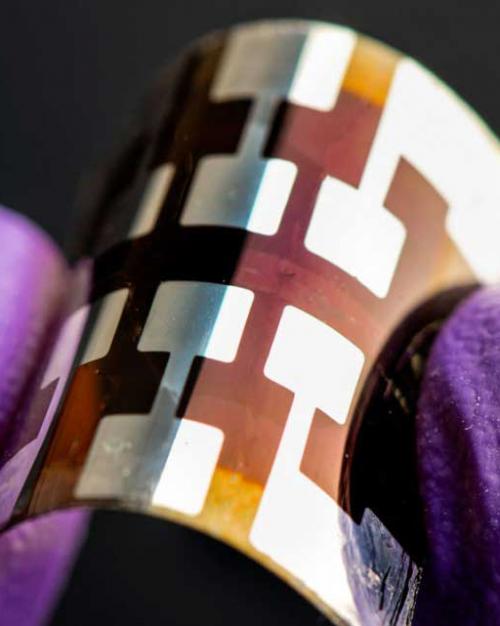A first-of-its-kind study examining the thermal transport properties of a novel material is helping steer the future of two-dimensional hybrid perovskites – a relatively new class of materials with exciting potential for photovoltaic, optoelectronic and thermoelectric applications.
The perovskite family of materials has shown great promise for improving solar cells, LED lights and other devices because of its unique mechanical, electrical and optical properties, and researchers, including Zhiting Tian, associate professor of mechanical and aerospace engineering in the College of Engineering, and Brad Ramshaw, the Dick & Dale Reis Johnson Assistant Professor of physics in the College of Arts and Sciences, have also discovered unique thermal abilities in the family.
But perovskites are notoriously unstable, limiting the lifespans of their applications. As a potential solution, some researchers are investigating a two-dimensional hybrid version of perovskites, with atomically thin organic and inorganic layers stacked together, creating the same crystal structure that defines a perovskite, but with more stability and control.
Led by Tian, a group of researchers conducted the first study of phonon dispersion in a 2D hybrid material, observing how X-rays scattered as they passed through, providing valuable data on the material’s ability to transport heat. The results are detailed in the paper “Remarkably Weak Anisotropy in Thermal Conductivity of Two-Dimensional Hybrid Perovskite Butylammonium Lead Iodide Crystals,” published May 3 in the journal Nano Letters.
The study of butylammonium lead iodide showed the 2D crystal structure shares some attributes of 3D perovskites. In particular, the material was found to have ultralow thermal conductivity, much like a 3D perovskite studied by Tian in 2019. But the 2D structure also showed remarkably weak anisotropy in thermal conductivity, meaning it showed comparable capabilities to conduct heat in different directions.
Just as a block of wood is weaker along its grain than perpendicular to the grain, various properties of crystals typically have different values when measured in different directions. This is especially true for layered structures. But the 2D crystal investigated by Tian was found to have similar thermal conductivity throughout the material.
“It was very interesting,” Tian said. “I knew this material would be special because of its combination of organic and inorganic components and the preferential orientation of the organic chains, but I had never seen such low anisotropy before. We wanted to look deeper and try to explain it in detail.”
Understanding the material’s unique thermal transport ability requires a combination of techniques, including synthesis, characterization and computational modeling. To obtain the in-plane thermal diffusivity, Tian used a technique known as transient thermal grating, employing two laser beams to create a temperature grating on tmaterial, and then a third to probe the thermal response. This was the first in-plane thermal measurement of a 2D hybrid perovskite.
Tian also used a synchrotron-based inelastic X-ray scattering and spectral energy density calculations to determine the dispersion relation of phonons – particles responsible for heat conduction – which revealed details of the material’s unique lattice dynamics – the way in which its atoms vibrate.
“It’s a pretty challenging process because of the complex crystal structure. Also, the energy resolution of the inelastic X-ray scattering couldn’t really go down to a very low frequency,” Tian said. “That’s why we combined the techniques with computation to get the dispersion.”
What their detailed analysis found was that depending on the direction the phonons were traveling, the phonon lifetimes were slightly different while the phonon group velocities were fairly close. The result comes from several competing effects that offset each other, leading to the material’s small anisotropy.
Aside from applications in thermoelectric devices that can convert heat directly into electricity, Tian said the research could help improve ‘hot-carrier’ solar cells, where ultralow thermal conductivity is desired to achieve high power conversion efficiency.
“The idea is you try to collect the excited charge carriers before they thermalize, and this material’s nearly isotopically low thermal conductivity can provide just what you need to slow down that thermalization,” said Tian, who added that more foundational research into 2D hybrid perovskites is required before understanding their true capabilities.
The study was funded by the National Science Foundation and the U.S. Department of Energy, and was performed at the Argonne National Laboratory, the Cornell NanoScale Science and Technology Facility and the Cornell Center for Materials Research.
Co-authors include Shefford Baker, associate professor of materials science and engineering (Engineering); Brad Ramshaw in the College of Arts and Sciences, the Dick and Dale Reis Johnson Assistant Professor; and researchers from Duke University, the University of Delaware and Cittadella Universitaria, Italy.
Syl Kacapyr is public relations and content manager for the College of Engineering.





